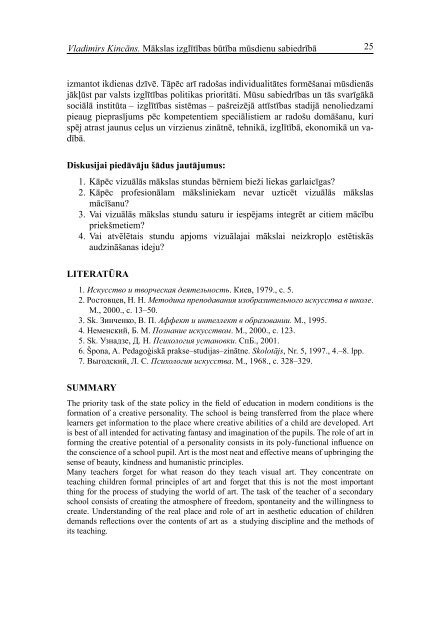Viltusdraugi - Latvijas Universitāte
Viltusdraugi - Latvijas Universitāte
Viltusdraugi - Latvijas Universitāte
Create successful ePaper yourself
Turn your PDF publications into a flip-book with our unique Google optimized e-Paper software.
Vladimirs Kincāns. Mākslas izglītības būtība mūsdienu sabiedrībā<br />
izmantot ikdienas dzīvē. Tāpēc arī radošas individualitātes formēšanai mūsdienās<br />
jākļūst par valsts izglītības politikas prioritāti. Mūsu sabiedrības un tās svarīgākā<br />
sociālā institūta – izglītības sistēmas – pašreizējā attīstības stadijā nenoliedzami<br />
pieaug pieprasījums pēc kompetentiem speciālistiem ar radošu domāšanu, kuri<br />
spēj atrast jaunus ceļus un virzienus zinātnē, tehnikā, izglītībā, ekonomikā un vadībā.<br />
Diskusijai piedāvāju šādus jautājumus:<br />
1. Kāpēc vizuālās mākslas stundas bērniem bieži liekas garlaicīgas?<br />
2. Kāpēc profesionālam māksliniekam nevar uzticēt vizuālās mākslas<br />
mācīšanu?<br />
3. Vai vizuālās mākslas stundu saturu ir iespējams integrēt ar citiem mācību<br />
priekšmetiem?<br />
4. Vai atvēlētais stundu apjoms vizuālajai mākslai neizkropļo estētiskās<br />
audzināšanas ideju?<br />
LITERATŪRA<br />
1. Искусство и творческая деятельность. Киев, 1979., с. 5.<br />
2. Ростовцев, Н. Н. Методика преподавания изобразительного искусства в школе.<br />
М., 2000., с. 13–50.<br />
3. Sk. Зинченко, В. П. Аффект и интеллект в образовании. М., 1995.<br />
4. Неменский, Б. М. Познание искусством. М., 2000., с. 123.<br />
5. Sk. Узнадзе, Д. Н. Психология установки. СпБ., 2001.<br />
6. Špona, A. Pedagoģiskā prakse–studijas–zinātne. Skolotājs, Nr. 5, 1997., 4.–8. lpp.<br />
7. Выгодский, Л. С. Психология искусства. М., 1968., с. 328–329.<br />
SUMMARY<br />
The priority task of the state policy in the field of education in modern conditions is the<br />
formation of a creative personality. The school is being transferred from the place where<br />
learners get information to the place where creative abilities of a child are developed. Art<br />
is best of all intended for activating fantasy and imagination of the pupils. The role of art in<br />
forming the creative potential of a personality consists in its poly-functional influence on<br />
the conscience of a school pupil. Art is the most neat and effective means of upbringing the<br />
sense of beauty, kindness and humanistic principles.<br />
Many teachers forget for what reason do they teach visual art. They concentrate on<br />
teaching children formal principles of art and forget that this is not the most important<br />
thing for the process of studying the world of art. The task of the teacher of a secondary<br />
school consists of creating the atmosphere of freedom, spontaneity and the willingness to<br />
create. Understanding of the real place and role of art in aesthetic education of children<br />
demands reflections over the contents of art as a studying discipline and the methods of<br />
its teaching.<br />
25

















